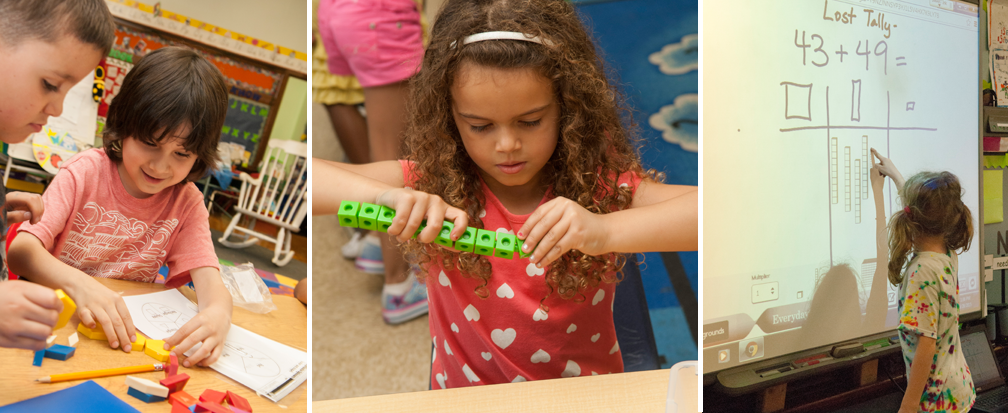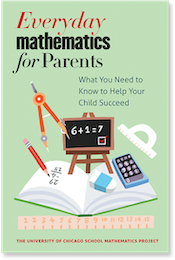Kindergarten Grade Level Goals
Everyday Mathematics third-edition Grade Level Goals have been revised to align with the Common Core State Standards for Mathematics (CCSS-M), which were widely adopted in 2010. Both versions of the curriculum's goals are available below. For more information on standards, please see Meeting Standards with Everyday Mathematics.
Common Core State Standards (CCSS) Edition Grade Level Goals
| Collapse All
Number and Numeration
| Program Goal | Content Thread | Grade-Level Goal |
|---|---|---|
| Understand the Meanings, Uses, and Representations of Numbers | Rote counting | Count on by 1s to 100; count on by 2s, 5s, and 10s and count back by 1s with number grids, number lines, and calculators. |
| Rational counting | Count 20 or more objects; estimate the number of objects in a collection. | |
| Place value and notation | Model numbers with manipulatives; use manipulatives to exchange 1s for 10s and 10s for 100s; recognize that digits can be used and combined to read and write numbers; read numbers up to 30. | |
| Meanings and uses of fractions | Use manipulatives to model half of a region or a collection; describe the model. | |
| Understand Equivalent Names for Numbers | Equivalent names for whole numbers | Use manipulatives, drawings, and numerical expressions involving addition and subtraction of 1 -digit numbers to give equivalent names for whole numbers up to 20. |
| Understand Common Numerical Relations | Comparing and ordering numbers | Compare and order whole numbers up to 20. |
Operations and Computation
| Program Goal | Content Thread | Grade-Level Goal |
|---|---|---|
| Compute Accurately | Addition and subtraction facts | Use manipulatives, number lines, and mental arithmetic to solve problems involving the addition and subtraction of single-digit whole numbers; demonstrate appropriate fluency with addition and subtraction facts within 5. |
| Understand Meanings of Operations | Models for the operations | Identify join and take-away situations. |
Data and Chance
| Program Goal | Content Thread | Grade-Level Goal |
|---|---|---|
| Select and Create Appropriate Graphical Representations of Collected or Given Data | Data collection and representation | Collect and organize data to create class-constructed tally charts, tables, and bar graphs. |
| Analyze and Interpret Data | Data analysis | Use graphs to answer simple questions. |
| Understand and Apply Basic Concepts of Probability | Qualitative probability | Describe events using certain, possible, impossible, and other basic probability terms. |
Measurement and Reference Frames
| Program Goal | Content Thread | Grade-Level Goal |
|---|---|---|
| Understand the Systems and Processes of Measurement; Use Appropriate Techniques, Tools, Units, and Formulas in Making Measurements | Length, weight, and angles | Use nonstandard tools and techniques to estimate and compare weight and length; identify standard measuring tools. |
| Money | Identify pennies, nickels, dimes, quarters, and dollar bills. | |
| Use and Understand Reference Frames | Temperature | Describe temperature using appropriate vocabulary, such as hot, warm, and cold; identify a thermometer as a tool for measuring temperature. |
| Time | Describe and use measures of time periods relative to a day and week; identify tools that measure time. |
Geometry
| Program Goal | Content Thread | Grade-Level Goal |
|---|---|---|
| Investigate Characteristics and Properties of Two- and Three-Dimensional Geometric Shapes | Plane and solid figures | Identify and describe plane and solid figures including circles, triangles, squares, rectangles, spheres, and cubes. |
| Apply Transformations and Symmetry in Geometric Situations | Transformations and symmetry | Identify shapes having line symmetry. |
Patterns, Functions, and Algebra
| Program Goal | Content Thread | Grade-Level Goal |
|---|---|---|
| Understand Patterns and Functions | Patterns and functions | Extend, describe, and create visual, rhythmic, and movement patterns; use rules, which will lead to functions, to sort, make patterns, and play "What_s My Rule?" and other games. |
| Use Algebraic Notation to Represent and Analyze Situations and Structures | Algebraic notation and solving number sentences | Read and write expressions and number sentences using the symbols +, -, and =. |
3rd Edition Grade Level Goals
| Collapse All
Number and Numeration
| Program Goal | Content Thread | Grade-Level Goal |
|---|---|---|
| Understand the Meanings, Uses, and Representations of Numbers | Rote counting | Count on by 1s to 100; count on by 2s, 5s, and 10s and count back by 1s with number grids, number lines, and calculators. |
| Rational counting | Count 20 or more objects; estimate the number of objects in a collection. | |
| Place value and notation | Model numbers with manipulatives; use manipulatives to exchange 1s for 10s and 10s for 100s; recognize that digits can be used and combined to read and write numbers; read numbers up to 30. | |
| Meanings and uses of fractions | Use manipulatives to model half of a region or a collection; describe the model. | |
| Equivalent names for whole numbers | Use manipulatives, drawings, and numerical expressions involving addition and subtraction of 1 -digit numbers to give equivalent names for whole numbers up to 20. | |
| Comparing and ordering numbers | Compare and order whole numbers up to 20. |
Operations and Computation
| Program Goal | Content Thread | Grade-Level Goal |
|---|---|---|
| Models for the operations | Addition and subtraction procedures | Use manipulatives, number lines, and mental arithmetic to solve problems involving the addition and subtraction of single-digit whole numbers. |
| Understand Meanings of Operations | Models for the operations | Identify join and take-away situations. |
Data and Chance
| Program Goal | Content Thread | Grade-Level Goal |
|---|---|---|
| Select and Create Appropriate Graphical Representations of Collected or Given Data | Data collection and representation | Collect and organize data to create class-constructed tally charts, tables, and bar graphs. |
| Analyze and Interpret Data | Data analysis | Use graphs to answer simple questions |
| Understand and Apply Basic Concepts of Probability | Qualitative probability | Describe events using certain, possible, impossible, and other basic probability terms. |
Measurement and Reference Frames
| Program Goal | Content Thread | Grade-Level Goal |
|---|---|---|
| Understand the Systems and Processes of Measurement; Use Appropriate Techniques, Tools, Units, and Formulas in Making Measurements | Length, weight, and angles | Use nonstandard tools and techniques to estimate and compare weight and length; identify standard measuring tools. |
| Money | Identify pennies, nickels, dimes, quarters, and dollar bills. | |
| Use and Understand Reference Frames | Temperature | Describe temperature using appropriate vocabulary, such as hot, warm, and cold; identify a thermometer as a tool for measuring temperature. |
| Time | Describe and use measures of time periods relative to a day week; identify tools that measure time. |
Geometry
| Program Goal | Content Thread | Grade-Level Goal |
|---|---|---|
| Investigate Characteristics and Properties of Two- and Three-Dimensional Geometric Shapes | Plane and solid figures | Identify and describe plane and solid figures including circles, triangles, squares, rectangles, spheres, and cubes. |
| Apply Transformations and Symmetry in Geometric Situations | Transformations and symmetry | Identify shapes having line symmetry. |
Patterns, Functions, and Algebra
| Program Goal | Content Thread | Grade-Level Goal |
|---|---|---|
| Understand Patterns and Functions | Patterns and functions | Extend, describe, and create visual, rhythmic, and movement patterns; use rules, which will lead to functions, to sort, make patterns, and play "What’s My Rule?" and other games. |
| Use Algebraic Notation to Represent and Analyze Situations and Structures | Algebraic notation and solving number sentences | Read and write expressions and number sentences using the symbols +, -. And =. |




